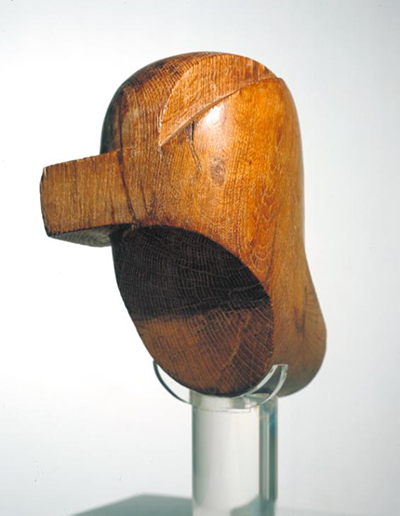Constantin Brancusi's Head (c.1919–23), originally titled Tête, has a controversial history stretching back to 1913 and his first sculpture on wood.
From a young age, Brancusi was fascinated with woodwork and by 1908, he focused primarily on carving, defying the extant sculptural trend of metal casting. However, similar to his contemporaries such as Paul Gauguin and Pablo Picasso, he drew inspiration from Non–Western cultures and amalgamated their style with his Romanian folk origins. The First Step (1913), a depiction of a child taking its first step, was the outcome of this marriage of cultures. After seven crayon studies on paper, Brancusi carved this sculpture from wood, referencing the carpeting traditions of his homeland. By using the idealized naturalism and geometrically conceived forms of African Art, he aimed to capture the essence of uncertainty when foraying into the world.
Scholars such as Sidney Geist, a Brancusi expert, believe he was inspired by a Bambara figure from the Musée de l’Homme, whilst others support that he was inspired by his Farquhar friends' infant. Both schools of thought also entertain the idea of the allegoric reference of his venture into wood. A year after exhibiting The First Step, listed as The Prodigal Son, at the Armory Show in 1913, Brancusi destroyed the sculpture but preserved the head. Speculations of the destruction are either due to the work failing to be exhibited again or because Brancusi had renounced the influence of African art. The head was renamed First Cry and Brancusi used it as an architype for his marble sculpture Newborn I (1915) and First Cry (bronze, 1917).
Little French Girl II or Plato (c.1917) was a rework of ‘The First Step’ and was similarly carved from one block of oak wood. Brancusi maintained the forms of the head but outstretched the mouth, balancing it on an elongated pole-like neck, tortoise's shell pelvis, legs and bulging geometrical feet. 1914 – 17 was his most experimental period and the fluidity and playfulness of his work reflected his affiliation with the Dadaist movement. He experimented with many of his sculptures by photographing them in various configurations, with the photographs being the sole documentation.
Little French Girl II was photographed along with sculptures Endless Column, and Cup II and the arrangement was called The Child in the World: Mobile Group.5. Brancusi claimed that it depicted Socrates' death in Plato's presence with a cup of hemlock. However, scholars support that the arrangement is a portrayal of himself with composer Erik Satie, who addressed each other as Plato and Socrates and the latter's bowler hat. Around 1923, Brancusi beheaded the sculpture, preserved the head and disposed of the body. The Head was included in numerous exhibitions and in the early 50s, Brancusi sold it to Yolanda Penteado. In March 1980, she actioned the sculpture at Sotheby's and was sold to Tate Modern, London UK. The sculpture is currently on display at Tate St Ives in Liverpool.




